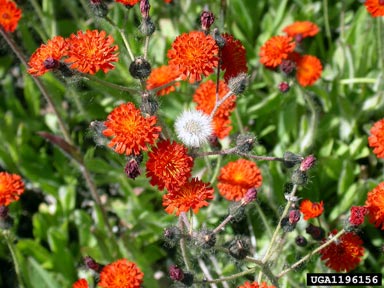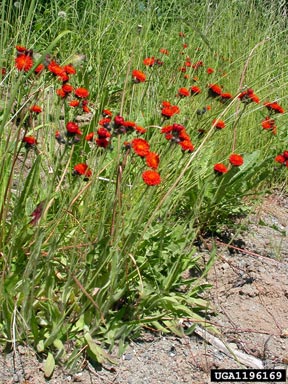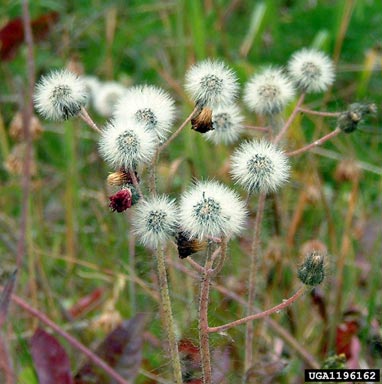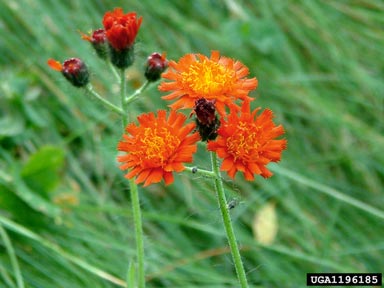Learning objectives
- Understand biology, and identification of orange hawkweed
- Understand impacts of orange hawkweed, and mitigating impacts with IPM goals
- Understand prevention strategies for orange hawkweed
- Understand control strategies for orange hawkweed
- The species
a. General description, Biology, invasive potential
Orange hawkweed is a perennial forb in the sunflower family that is native to Eurasia. Likely introduced as a garden ornamental orange hawkweed is a successful weed invading much of the northern United States and Canada. In Alaska, orange hawkweed is widespread in Southcentral and Southeast Alaska with some populations in remote communities. However, the weed is not known to grow north of the Alaska Range.

Orange hawkweed produces many seeds that include a pappus that aids in seed dispersal. Orange hawkweed seeds are viable for up to seven years, and can be produced by apomixis meaning that sexual reproduction is not required. Plants also reproduce asexually through spreading rhizomes (below ground roots), and stolons (above ground stems). Hawkweed is suspected to be allelopathic, meaning it produces chemicals that act as herbicides or otherwise change soil characteristics to favor its’ growth over other plant species. Plants can resprout from any root fragments that are left in the soil after a plant is removed. The competitive advantages that orange hawkweed has over other species is made evident by the formation of monocultures among aggressive species such as grasses. Hawkweed grows in a variety of habitats including meadows, roadsides, waste areas, lawns, pastures, and hay fields. It is less vigorous in heavy shade, with an apparent preference for areas of full sun.
Orange hawkweed is a Prohibited Noxious Weed in Alaska. The “prohibited” status means that it cannot be sold as seed or plant, or be included as a contaminant of anything that could be used for planting.
b. Identification
Orange hawkweed has shallow fibrous roots. Plant leaves form a basal rosette, and leaves are reduced and sparse, if not absent, from stems. Plants form above ground secondary stems called stolons that form roots from the apical node, aiding in vegetative reproduction.

Leaves are oblanceolate to elliptic, and contain soft white hairs giving the plant a fuzzy appearance. One flowering stem forms per basal rosette. Dark soft hairs cover the stem and the underside of the flowers. Stems and leaves leak a milky white substance when broken. Many, up to 30, flower heads each about a ½ inch wide form at the top of the stem. Flowers are made of ray florets that are red near the edges and orange in the center. Seeds are purplish black, oblong and about 1/8th an inch long with a pappus to aid in dispersal by wind.

c. Similar species and native look-a-likes
There are several hawkweed species in Alaska including native and non-native species you should be aware of. Orange hawkweed is the only orange colored hawkweed and orange colored sunflower family plant in Alaska. All other hawkweed species have yellow flowers. Native hawkweed species have smaller flower heads, less than 3/8 of an inch wide, than the non-native hawkweeds.

Most non-native hawkweeds are also weedy or invasive. Narrow leaved hawkweed (Hieracium umbellatum) is native to most of North America, but believed to have been introduced to Alaska. It is the most widespread of the non-native hawkweeds found from just north of the Arctic Circle to Southeast Alaska. It is distinguished from other hawkweeds because it does not form a basal rosette and has prominent leaves on the entire stem. Meadow hawkweed (H. caespitosum) has erect solitary stems with starlike hairs and forms up to 30 yellow flowerheads. Mouseear hawkweed (H. Pilosella) has a basal rosette and forms only 1 yellow flowerhead per stem.
d. Introduction to North America and Alaska
Orange hawkweed was introduced to Alaska as an ornamental species by gardeners that were unaware of its aggressive behavior. Often small communities in Alaska can recall who introduced orange hawkweed, where and when because it quickly spread to other locations. When looking for hawkweed in a community, cemeteries are a great place to start. Animals, including wildlife may spread hawkweed when they travel through infested areas.Orange hawkweed also spreads as a contaminant of vehicles, machinery, hay and straw, and gravel and soil, and is often found on roadsides.
To understand more about the interaction between some weeds and roadsides view this video clip.
